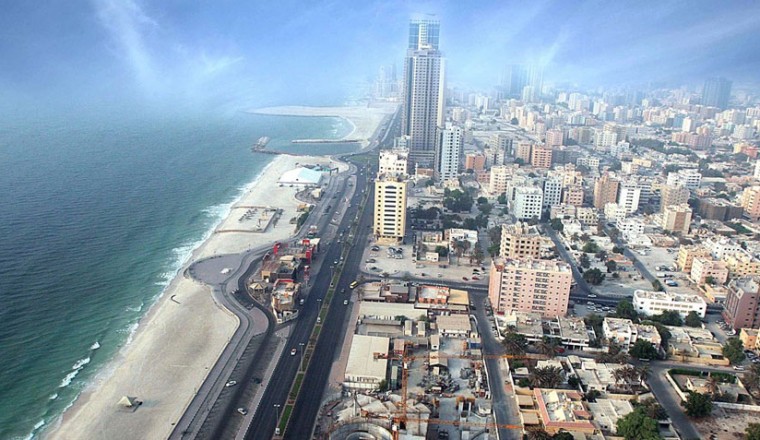

One of the major Ajman tourist attractions, the Sheikh Zayed Mosque is an impressive traditional architecture of sacred importance. A little on the outskirts of the city, it was officially opened by the Ajman ruler Sheikh Humaid bin Rashid. Built on a sprawling area of 37000 sq. meters, the scared mosque can accommodate 2500 worshippers at a time.
Dhow building yard of Ajman
Renowned as the world’s largest dhow building center, it is one of the best places to visit in Ajman. It’s a great sight to see Dhows getting built using traditional methods and tools from the experienced hands who are trained in this skill sets by their earlier generations. The most amazing part of building the Dhows are the fact that they don’t have any blueprint at all.
Historically, wooden dhows played a vital role in fishing, pearling and trading across the region. Ajman’s Dhow Yard remains one of the world's largest dhow-building centres.
You’ll find the Dhow Yard on the north side of Ajman Creek, near Al Boom Marine.
Here, you can watch master craftsmen at work, using tools and techniques that have been handed down from generation to generation. The yard also makes fiberglass dhows, powered by diesel engines, for racing events across the country.
Mowaihat archaeological site
It is an archaeological site which is located towards the outskirts of Ajman. When the place was discovered, the Mowaihat tomb was a sign of Umm al-Nar civilization in the Northern Emirates. Further excavation, revealed that this period also existed in the other major cities of Gulf of Al Sufouh, Tell Abraq and Shimal. Here are several pieces of evidence, such as tools, toys and other items of daily life used along with the skeletons of the original inhabitants of the area. However, most items that were obtained from Mowaihat, are displayed in the Ajman Museum and form the largest part of the museum's exhibition.
Ajman Fish Market
With a huge array of fresh fish and seafood for sale, Ajman’s bustling Fish Market is popular with visitors and locals alike. Haggling with the friendly fishmongers is expected, and you can get your fish filleted, spiced and grilled on the spot at one of the simple stalls.
Follow your nose – and Sheikh Rashid bin Saeed Al Maktoum Street – to the Al Rashidiya area near the creek. The market is open daily from 7am - 1:30pm, and 5pm - 10pm with a spirited auction each evening from 6pm.
The Ajman Corniche
Lined with cafés and restaurants, the Corniche is a four-kilometre-long esplanade overlooking the Arabian Gulf. Much of the emirate’s social activities and events are centred on this area
Situated along the northwestern shore of the emirate, the Corniche road (or Sheikh Humaid bin Rashid Al Nuaimi Street) stretches from the roundabout just after Coral Beach Resort Sharjah to the five-star Kempinski Hotel Ajman.
Soak up the sun during the day with an afternoon walk, or go for a swim in the sheltered tidal pool. The area really comes to life during the evening and on weekends, so join the locals enjoying barbeques and picnics on the beach, or visit one of the many casual restaurants such as Attibrah and Themar Al Bahar.
Ajman Marina
Ajman Marina is one of the emirate’s newest developments. It features a 1.5-kilometre-long esplanade that is popular with joggers, cyclists and families out for an evening stroll.
To get to the marina, head to the end of the Corniche near the Kempinski Hotel Ajman. Then walk down the street past the Ruler’s Court and you will find the waterfront area.
While the planned yacht club will one day lure yachties and game fishermen, in the meantime, there are a number of cafés and casual restaurants. Don’t miss Salt, a trendy burger van serving Wagyu beef sliders from a silver Airstream, alongside an alfresco seating area with umbrella-shaded tables.
Ajman Museum
Ajman Museum is the emirate’s foremost museum illustrating life as it once was. The 18th-century fort served as the ruler’s residence until 1970, before it was converted into a museum a decade later.
You’ll find the museum on the east side of the central square in the Al Bustan area. It is open every day between 8am and 8pm, except on Fridays and public holidays, and displays are annotated in both Arabic and English.
The exhibits offer a compelling glimpse of Ajman’s past, from centuries-old manuscripts and weaponry to models of wooden dhows and ingenious irrigation systems. One of the most notable displays is an excavated cemetery discovered in the Al Muwaihat area, which features pottery and funeral jewellery dating back as far as 3000 BC. A section is devoted to the pearl trade that once dominated the region, while the fort itself is a perfect example of traditional Emirati architecture.
Find more at www.whatsupajman.com



















Facebook Conversations
Disqus Conversations